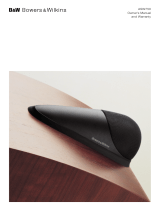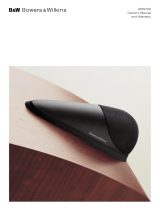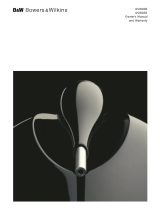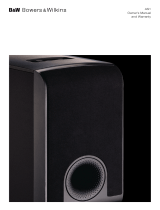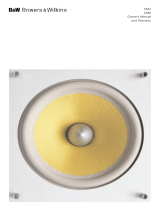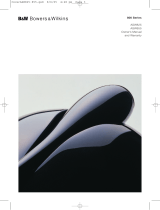Page is loading ...

800 Series
ASW825
ASW855
Owner’s Manual

1
Contents
English
Owner’s Manual............2
Limited Warranty...........7
Français
Manuel d’utilisation.......8
Garantie limitée...........14
Deutsch
Bedienungsanleitung...15
Beschränkte Garantie .21
Español
Manual de
instrucciones ..............22
Garantía limitada.........28
Português
Manual do utilizador....29
Garantia limitada.........35
Italiano
Manuale di istruzioni ...36
Garanzia limitata .........41
Nederlands
Handleiding ................42
Beperkte garantie .......48
Ελληνικά
Ãδηγίες Ìρήσεως ....49
Περιïρισµένη
εγγύηση....................56
Русский
Руководство по
эксплуатации ............57
Ограниченная
гарантия....................64
Norsk
Bruksanvisning ...........65
Tidsbegrenset
garanti........................66
Svenska
Bruksanvisning ...........67
Begränsad garanti ......69
Suomi
Omistajan kasikirja......70
Takuuehdot.................71
.....................72
.......................77
.......................78
.......................82
EU Declaration of
Conformity..................86
Technical
Specifications .......87–88
6489 ASW 825_855 inside.qxd 20/8/07 09:55 Page 1

English
Owner’s manual
IMPORTANT SAFETY
INSTRUCTIONS
Caution:
To reduce the risk of electric shock, do not remove the
back panel. No user-serviceable parts inside. Refer
servicing to qualified personnel.
Explanation of Graphical Symbols:
The lightning flash within an equilateral
triangle is intended to alert you to the
presence of uninsulated “dangerous
voltage” within the product’s enclosure
that may be of sufficient magnitude to
constitute an electric shock to persons.
The exclamation point within an
equilateral triangle is intended to alert
you to the presence of important
operating and maintenance (servicing)
instructions in the literature
accompanying the appliance.
WARNINGS:
1 Read Instructions – All the safety and operating
instructions should be read before the appliance is
operated.
2 Retain Instructions – The safety and operating
instructions should be retained for future reference.
3 Heed Warnings – All warnings on the appliance
and in the operating instructions should be
adhered to.
4 Follow Instructions – All operating and use
instructions should be followed.
5 Installation – Install in accor
dance with the
manufacturer's instructions.
6 Power Sources – This product should be operated
only from the type of power source indicated by
the marking situated on the rear panel. If you are
not sure of the type of power supply to your home,
consult your pr
oduct dealer or local power
company.
7 Grounding or Polarisation – The appliance is not
required to be grounded. Ensure the plug is fully
inserted into the wall outlet or extension cor
d
receptacle to prevent blade or pin exposure. Some
versions of the product are equipped with a power
cor
d fitted with a polarised alter
nating line plug (a
plug having one blade wider than the other). This
p
lug will fit onto the power outlet only one way.
This is a safety feature. If you are unable to insert
t
he plug fully into the outlet, try reversing the plug.
I
f the plug should still fail to fit, contact your
electrician to replace your obsolete outlet. Do not
d
efeat the safety purpose of the polarised plug.
When using an extension power-supply cord or a
power-supply cord other than that supplied with
t
he appliance, it should be fitted with the
appropriate moulded-on plugs and carry safety
a
pproval appropriate to the country of use.
8
Power Cord Protection – Power-supply cords
should be routed so that they are not likely to be
w
alked on or pinched by items placed on or
against them, paying particular attention to cords
a
t plugs, convenience receptacles and the point
where they exit from the appliance.
9 Overloading – Do not overload wall outlets,
extension cords or integral convenience
receptacles, as this can result in a risk of fire or
electric shock.
10 Ventilation – The amplifier panel at the rear of the
product forms part of the cooling mechanism and
must not be obscured by placing the product on a
bed, sofa, rug, or other similar surface. Do not
cover the amplifier panel with any items such as
tablecloths, newspapers, etc. Ensure the heat sink
fins are aligned vertically to ensure proper cooling.
There should be a clear gap of at least 50mm (2-
in) between the back of the product and any wall
or partition. If the product is placed in a built-in
installation, such as a rack, bookcase or cabinet,
proper provision for air to circulate must be
provided, either by a) 12mm (1/2-in) clear gap
round the top, sides and bottom of the product
venting into the room or b) two ducts of 150 sq cm
(24 sq in) minimum cross section from the room
leading to slots 300mm (12-in) wide x 50mm
(2-in) deep at top and bottom of the compartment,
in line with the gap behind the product.
11 Heat – The product should be situated away from
heat sources such as radiators, heat registers,
stoves, or other products (including amplifiers) that
produce heat. No naked flame sources, such as
lighted candles, should be placed on the
apparatus.
12 Wall or Ceiling Mounting – The product should be
mounted to a wall or ceiling only as recommended
by the manufactur
er.
13
W
ater and Moistur
e – T
o reduce the risk of fire or
electric shock, do not expose the product to rain
or excessive moistur
e such as in a sauna or
bathroom. Do not use this product near water – for
example, near a bathtub, washbowl, kitchen sink,
laundry tub, in a wet basement, or near a
swimming pool and the like.
14 Object and Liquid Entry – Never push objects of
any kind into this product through openings, as
they may touch danger
ous voltage points or short
out parts that could r
esult in a fire or electric
2
CAUTION
RISK OF ELECTRIC SHOCK
DO NOT OPEN
6489 ASW 825_855 inside.qxd 20/8/07 09:55 Page 2

shock. Never spill liquid of any kind on the
p
roduct. Do not place any object containing liquid
on top of the product.
15 Cleaning – Unplug the product from the wall outlet
b
efore cleaning. The cabinet of the subwoofer may
be cleaned by dusting with a dry cloth. If you wish
to use an aerosol cleaning spray, do not spray
d
irectly on the cabinet; spray onto the cloth.
Remove the grille first so that the cloth does not
become stained, but be careful not to disturb the
d
rive unit. The grille itself may be cleaned using a
soft brush.
1
6 Attachments – Do not use attachments not
r
ecommended by the product manufacturer, as
they may cause hazards.
17 Accessories – Do not place this product on an
unstable cart, stand, tripod, bracket or table. The
product may fall, causing serious injury to a child
or adult, and serious damage to the product. Use
only with a cart, stand, tripod, bracket or table
recommended by the manufacturer or sold with
the product. Any mounting of the product should
follow the manufacturer’s instructions and should
use a mounting accessory recommended by the
manufacturer.
18 Moving the appliance – A product and cart
combination should be moved with
care. Quick stops, excessive force
and uneven surfaces may cause the
product and cart combination to
overturn. Check that there are no
cables under the carpet that may be damaged by
the spike feet. Do not walk the product on the
spike feet as this may cause them to become
detached from the cabinet and cause damage.
Take care not to impale yourself with the spike
feet.
19 Non-use Periods – The power cord of the
appliance should be unplugged from the outlet
during lightning storms or when the apparatus is
left unused for a long period of time.
20 Servicing – Do not attempt to service this product
yourself, as opening or removing covers may
expose you to dangerous voltage or other hazards.
Refer all servicing to qualified service personnel.
21 Damage Requiring Service – Unplug this product
from the wall outlet and refer servicing to qualified
personnel under the following conditions:
a When the power-supply cord or plug has been
damaged.
b If liquid has been spilled or objects have fallen
into the appliance.
c If the product has been exposed to rain or
water.
d If the product does not operate normally by
following the operating instructions. Adjust only
those controls that are covered by the operating
instructions, as an improper adjustment of other
contr
ols may r
esult in damage and will often
require extensive work by a qualified technician
t
o restore the product to its normal operation.
e
If the product has been dropped, or damaged in
any way.
f When the product exhibits a distinct change in
p
erformance – this indicates a need for service.
2
2 Replacement Parts – When replacement parts are
required, be sure the service technician has used
replacement parts specified by the manufacturer or
h
ave the same characteristics as the original part.
Unauthorised substitutions may result in fire,
e
lectric shock or other hazards.
23 Mains Fuses – For continued protection against fire
hazard, use fuses only of the correct type and
rating. The amplifier is designed to operate with
nominal mains supplies in the range 100V to 230V
AC, but different types of fuse are used,
dependent on the mains voltage. The correct fuse
specification for each voltage range is marked on
the product.
24 Safety Check – Upon completion of any service or
repairs to this product, ask the service technician
to perform safety checks to determine that the
product is in proper operating condition.
25 Magnetic Fields – the product creates a stray static
magnetic field. Do not place any object that may
be damaged by this magnetic field (eg cathode ray
tube televisions or computer monitors, audio and
video tapes and swipe car
ds) within 0.5m (2 feet)
of the appliance. The appliance may cause
distortion of cathode ray tube images beyond this
distance.
Introduction
Thank you for purchasing a B&W ASW Active
Subwoofer.
Since its foundation in 1966, the continuing
philosophy of B&W has been the quest for perfect
sound reproduction. Inspired by the company’s
founder, the late John Bowers, this quest has entailed
not only high investment in audio technology and
innovation but also an abiding appreciation of music
and the demands of film sound to ensure that the
technology is put to maximum effect.
This subwoofer has been designed for Home Theatre
installations and to augment the bass performance of
full-range speakers in 2-channel audio use. Adding the
subwoofer to your system not only extends the bass
to lower fr
equencies, it impr
oves the midrange clarity
by reducing the low-frequency demands on your
existing speakers.
Please read through this manual fully before using the
subwoofer. All sound installations require some
planning and experimentation if you ar
e to get the best
out of the products used and this manual will guide
you in this process.
3
6489 ASW 825_855 inside.qxd 20/8/07 09:55 Page 3

As the subwoofer is connected to the electricity power
s
upply, it is important that you familiarise yourself with
the safety instructions and heed all warnings.
Keep this manual in a safe place for future reference.
B&W products are distributed to over 60 countries
w
orldwide and we maintain an international network of
carefully chosen and dedicated distributors. If you
have a problem, which your dealer cannot resolve, our
d
istributors will be more than willing to assist you.
Environmental Information
A
ll B&W products are designed to comply
with international directives on the
R
estriction of Hazardous Substances
(RoHS) in electrical and electro
nic equipment and the
d
isposal of Waste Electrical and Electronic Equipment
(WEEE). These symbols indicate compliance and that
the products must be appropriately recycled or
processed in accordance with these directives. Consult
your local waste disposal authority for guidance.
Unpacking
(figure 1)
The easiest way to unpack the subwoofer and avoid
damage is as follows:
• Open the carton flaps right back and invert the
carton and contents.
• Lift the carton away from the product.
We recommend that you retain the packaging for
future use.
In addition to this manual, the carton should contain:
1 Subwoofer
1 Accessory pack containing:
4 Rubber feet
4 Spike feet
4 Lock nuts
1 International warranty document
A tour of the subwoofer
(figure 2)
1 Power/Standby indicator
2 VOLUME control
3 LOW-PASS FREQUENCY control
4 MODE On/Auto/Standby switch
5 Equalisation switch
6 LOW-PASS FILTER defeat switch
7
Phase switch
8 LINE IN
9 LINE OUT
10
LINK OUT
11
POWER on/of
f switch
12 Fuse holders
13 Power input socket
Positioning the subwoofer
Because the subwoofer produces only low-frequency
sounds, positioning is less critical in some respects
c
ompared to full-range speakers. Directional
information is much less precise and you have more
choice where to place the speakers to good effect.
T
his said, best results are obtained if the subwoofer is
placed between the satellite speakers or in the vicinity
o
f one of them. If you use two subwoofers, it is best
t
o put one near each satellite speaker.
Placing the subwoofer behind the listeners, even in
s
urround sound installations, generally gives inferior
i
maging, but may be an acceptable compromise if
domestic considerations dictate.
As with all speakers, the proximity of room boundaries
a
ffects the sound. Bass is generally increased as more
surfaces come into close proximity with the speakers.
Unlike full-range speakers, however, you can always
restore the correct overall system balance by adjusting
the volume level of the subwoofer. The more boost
you get from the room, the less hard the speaker has
to work; but there is a down side. Corner positions
often excite more low-frequency room resonances,
making the bass more uneven with frequency. There is
no substitute for experiment as all rooms behave
differently, so try the subwoofer in a variety of
positions before making a final decision. A piece of
music with a bass line ascending or descending the
musical scale is useful for assessing the smoothness
of the bass response. Listen for exaggerated or quiet
notes. Having a separate subwoofer does enable you
to optimise for room resonances independently from
siting the satellite speakers for best imaging.
If the subwoofer is to be used in a confined space (eg
in custom furniture), the space must be ventilated to
allow sufficient air to circulate and cool the unit. Ask
your dealer for advice.
The subwoofer is supplied with four spike feet. The
spikes pierce through carpet pile, giving a firm support
directly to the floor surface without crushing the pile.
If the unit is to be placed on a vulnerable surface,
such as a wooden floor, either place a protective disc
under each spike or fit the four rubber feet in place of
the spikes.
When fitting either the rubber feet or the spike feet,
first screw the lock nuts fully onto the thread and then
screw the feet fully onto the threaded inserts in the
base of the cabinet. If the unit rocks, loosen the
relevant two opposing feet until the support is firm,
then re-tighten the lock nuts to the inserts.
Check that there are no cables under the carpet that
may be damaged by the spike feet.
Do not walk the pr
oduct on the spike feet as this may
cause them to become detached from the cabinet and
cause damage.
Take care not to impale yourself with the spike feet
when moving the pr
oduct.
4
6489 ASW 825_855 inside.qxd 20/8/07 09:55 Page 4

Electrical connections
Disconnect all sound system equipment from the
power supply until the signal connections have been
m
ade and checked. This avoids the risk of damage
whilst connections are made or broken.
The function of the subwoofer is to receive signals
f
rom the amplification chain and, where necessary for
2
-channel audio, split the signal into low bass and
higher frequencies and feed the latter back out to the
s
atellite speakers. Left and right channel inputs may
be combined into a single mono low bass feed to the
s
ubwoofer drive unit if required.
The subwoofer will input and output line-level signals
v
ia the RCA Phono sockets located on the back panel.
Use the following table to select the corre
ct wiring
method for your installation:
Application: Home Theatre
The subwoofer may be used with any decoder that
has a line-level subwoofer output (normally from an
RCA Phono socket). Most decoders with integral
power amplifiers still output the subwoofer or Low-
Frequency Effects (LFE) signal at line level.
• Decoder with one or more subwoofers – fig. 3
Application: 2-channel audio
Separate pre- & power amplifiers:
a One or more subwoofers with output combined
into a single mono signal – fig. 4
b Two subwoofers with separate left and right signal
– fig. 5
The subwoofer is not suitable for use with 2-channel
integrated pre/power amplifiers.
Using more than one subwoofer
Using more than one unit in a single installation can
improve performance in the following ways:
• Maintain stereo separation to the lowest
frequencies.
• Cope with larger listening rooms.
• Enable greater maximum sound output – often
useful for effectively reproducing special effects in
Home Theatre applications.
• Smooth out the effects of low-frequency room
resonances.
If you are using two subwoofers for
2-channel audio, separation is improved if each
channel has its own subwoofer, providing each one is
placed close to the r
elevant satellite speaker
. Only use
the mono connection of figure 4 if you cannot place
each subwoofer close to its satellite speaker.
Double-check the connections
Before auditioning the sound quality of your new
installation and fine-tuning it, double-check the
connections. All too often, users complain that they
cannot get a decent sound however they set the
controls, only to discover something has been wrongly
c
onnected. Make sure that:
•
The phasing is correct – there should be no
positive to negative connections to the satellite
s
peakers. If something is out of phase you may get
a fuzzy sound with an imprecise and floating
image, a lack of bass or a combination of the two.
• There are no left to right mix-ups – this can result,
f
or example, in the orchestra being the wrong way
round or, more disastrously, sounds on your Home
T
heatre going in the opposite direction to the
action on the scre
en.
Switching on and off
W
e recommend that you switch the subwoofer on
before any power amplifiers receiving signals from the
subwoofer. Similarly, when switching off, switch the
subwoofer off last.
The MODE standby/auto/on switch (4) does not isolate
the amplifier completely from the power supply. It
maintains a low-power input to an auxiliary sensing
circuit.
The switch (4) operates as follows:
On:
With the switch in this position, the amplifier remains
permanently on, and the light (1) glows green.
Auto:
On first switching the subwoofer to Auto, the amplifier
becomes fully active and the light (1) glows green.
After a period of about 5 minutes without an input
signal, the amplifier automatically reverts to standby
mode, and the light glows red. When an input signal is
detected, the amplifier automatically becomes fully
active and the light glows green.
Standby:
In this position, the amplifier is in permanent standby,
and the light glows red.
If the subwoofer is to be out of use for an extended
period of time, we recommend you isolate it from the
power supply, either by using the POWER switch (11)
or by removing the plug from the power socket.
Setting the controls
There are 5 controls to consider:
• The VOLUME control (2)
•
The LOW-PASS FREQUENCY control (3)
• The PHASE switch (7)
•
The LOW-P
ASS FIL
TER switch (6)
• The EQ (equalisation) switch (5)
The optimum settings depend on the other equipment
used with the subwoofer. If using more than one
subwoofer
, ensur
e the contr
ols on each one ar
e set
the same.
5
6489 ASW 825_855 inside.qxd 20/8/07 09:55 Page 5

Use with home theatre decoders
The B&W ASW Active Subwoofer is not a THX®
licensed component, but may be used with a THX®
c
ontroller if desired.
•
Set the decoder VOLUME control to the half way
(12 o’clock) position.
• The setting of the LOW-PASS FREQUENCY control
i
s irrelevant.
•
Set the PHASE switch initially to 0˚.
•
Set the LOW-PASS FILTER switch to OUT.
•
Set the EQ switch initially to position A.
S
ee also the section “Fine tuning”.
I
f you have a THX® controller, ensure that the
subwoofer function is enabled. When so configured it
incorporates all the filtering and level setting required
for the subwoofer in all modes. For level calibration,
the internal test noise and channel level controls in the
THX® controller should be used. In all cases the levels
should be set to obtain 75dB SPL (C-weighted) at the
listening position from the controller’s internal noise
test signal.
With other decoders, configure the front and surround
speakers to “large” or “small” as appropriate before
setting the levels. Use the internal noise test signal
and volume controls of the decoder to set the levels of
all the speakers. Only change the VOLUME control on
the subwoofer if there is not enough range in the
decoder to achieve the correct levels.
Inexpensive sound level meters are readily available
from electronics stores and should be used to
calibrate the levels. Refer to your decoder manual for
further details on how to set the levels.
Use for 2-channel audio
• Set the VOLUME control initially to the half way (12
o’clock) position.
• Set the LOW-PASS FREQUENCY initially to 80Hz.
• Set the LOW-PASS FILTER switch to IN.
• Set the EQ switch initially to position A.
• Set the PHASE switch initially to 0˚.
See also the section “Fine tuning”.
Fine-tuning
There are two settings of the EQ switch. Position B is
optimised to allow the subwoofer to provide the
highest listening levels, while position A gives greater
bass extension coupled with a tighter sound.
2-channel audio
The optimum settings of the PHASE switch and the
LOW-PASS FREQUENCY control are inter-related and
also dependent on the low-frequency cut-off
characteristic of the satellite speakers and the r
elative
positions of all the speakers in the installation.
Set the system up in the preferred position and play
some programme with a steady bass content. The
optimum setting for the LOW-PASS FREQUENCY
d
epends on several variables; the bass performance
and power handling of the satellite speakers, the
n
umber of subwoofers used and their position relative
t
o the satellite speakers. The range 80 – 90Hz is a
good starting point for the LOW-PASS frequency.
U
nless two subwoofers are used to preserve separate
right and left channel information and are sited close
to the relevant satellite speakers, using a higher cut-off
f
requency may compromise the stereo image and
should only be considered if the bass performance of
t
he satellite speakers is particularly limited.
A
t each setting of the cut-off frequency, listen with the
phase switch in both positions. The correct one is that
w
hich gives the fullest bass and that will depend on
the bass characteristics of your satellite speakers and
t
he relative distances of the subwoofer(s) and the
satellite speakers to the listeners. When using more
than one subwoofer, ensure that each one has its cut-
off frequency and phase switch set the same way.
Set the loudness of the subwoofer relative to the
satellite systems to your liking. Use a wide variety of
programme material to get an average setting. One
that sounds impressive on one piece may sound
overpowering on another. Listen at realistic levels as
the perception of balance varies with sound level.
Home theatre
The situation with home theatre is somewhat different
from 2-channel audio. The subwoofer (LFE) signal is a
separate channel rather than an extension of the
signal to the satellite speakers. The LOW-PASS filter is
switched out, because the decoder provides all the
filtering for any speakers set to “small”. However, the
position of the phase switch must still be assessed.
Normally the phase will be set to 0˚, but if the
subwoofer is positioned at a distance significantly
different from the other speakers, or the power
amplifier driving the other speakers happens to invert
the signal, the 180˚ position may be preferable. Listen
with the switch in both positions and choose the one
that gives the fullest sound. If there is little difference,
leave the switch at 0˚.
Decoders normally have a calibrated noise signal that
can be used to set the relative levels of all the
speakers, making the task somewhat more
straightforward than for 2-channel audio. However, do
not be afraid to alter the settings to your personal
preference. It is all too easy to get carried away with
the capabilities of the subwoofer, especially with some
special low-frequency effects. Often a more realistic
portrayal, and one more satisfying in the long term, is
to be had by setting the subwoofer level lower that the
standard calibration level.
All applications
If you get pr
oblems with lumpy bass – if certain bass
notes ar
e exaggerated more than others – then you
probably have a room interface problem and it is worth
experimenting with the placement of the subwoofer.
What may seem like small changes in position – 15cm
(6in) or so – can have a profound effect on the sound.
6
6489 ASW 825_855 inside.qxd 20/8/07 09:55 Page 6

Try raising the subwoofer clear of the floor as well as
l
ateral movement. The use of multiple subwoofers can
smooth the effects of room resonances, as each
s
ubwoofer will tend to excite resonances at different
f
requencies. If you alter the relative distances from the
subwoofer(s) and satellite speakers to the listeners
a
ppreciably, reassess the phase switch setting. You
should also check the level setting of the subwoofer
(using either the decoder output levels or the volume
c
ontrol on the subwoofer amplifier as appropriate), but
only after setting the phase correctly.
Taking care of the subwoofer
The cabinet surfaces usually only require dusting. If
you wish to use an aerosol or other cleaner, remove
the grille first by gently pulling it away from the
c
abinet. Spray aerosols onto the cleaning cloth, not
directly onto the product. Test a small area first, as
some cleaning products may damage some of the
surfaces. Avoid products that are abrasive, or contain
acid, alkali or anti-bacterial agents. Do not use
cleaning agents on the drive unit. The grille fabric may
be cleaned with a normal clothes brush whilst the
grille is detached from the cabinet. Avoid touching the
drive unit, as damage may result.
We have chosen the finest wood veneers for the
surface of the cabinet, but please be aware that, like
all natural materials, the veneer will respond to its
environment. Keep the product away from sources of
direct heat such as radiators and warm air vents to
avoid the risk of cracking. The wood is treated with an
ultra-violet resistant lacquer to minimise changes in
colour over time, but a degree of change is to be
expected. This effect may be particularly noticeable
where the area covered by the grille, or areas kept in
shadow, change more slowly than other areas. Colour
differences may be rectified by exposing all the veneer
surfaces equally and evenly to sunlight until the colour
is uniform. This process can take several days or even
weeks, but may be accelerated by careful use of an
ultra-violet lamp.
Do not use the subwoofer as a table. When in use,
objects left on top of the subwoofer are liable to rattle.
In particular, avoid the risk of liquids being spilled (eg
from drinks or vases of flowers).
If the system is taken out of use for a long period,
disconnect the subwoofer from the power supply.
Note: The subwoofer will automatically shut down if
driven excessively. If this occurs, re-set the subwoofer
by tur
ning it off then on again, using the power on/off
switch on the amplifier panel.
Limited Warranty
This product has been designed and manufactured to
the highest quality standards. However, if something
does go wrong with this product, B&W Group Ltd and
its national distributors warrant fr
ee of charge labour
(exclusion may apply) and replacement parts in any
country served by an official B&W distributor.
This limited warranty is valid for a period of five years
f
rom the date of purchase or two years for electronics
including amplified loudspeakers.
Terms and Conditions
1
The warranty is limited to the repair of the
equipment. Neither transportation, nor any other
c
osts, nor any risk for removal, transportation and
i
nstallation of products is covered by this warranty.
2
This warranty is only valid for the original owner. It
is not transferable.
3 This warranty will not be applicable in cases other
t
han defects in materials and/or workmanship at
the time of purchase and will not be applicable:
a for damages caused by incorrect installation,
connection or packing,
b for damages caused by any use other than correct
use described in the user manual, negligence,
modifications, or use of parts that are not made or
authorised by B&W,
c for damages caused by faulty or unsuitable
ancillary equipment,
d for damages caused by accidents, lightning, water,
fire heat, war, public disturbances or any other
cause beyond the reasonable control of B&W and
its appointed distributors,
e for products whose serial number has been
altered, deleted, removed or made illegible,
f if repairs or modifications have been executed by
an unauthorised person.
4 This guarantee complements any national/regional
law obligations of dealers or national distributors
and does not affect your statutory rights as a
customer.
How to claim repairs under warranty
Should service be required, please follow the following
procedure:
1 If the equipment is being used in the country of
purchase, you should contact the B&W authorised
dealer from whom the equipment was purchased.
2 If the equipment is being used outside the country
of purchase, you should contact the B&W national
distributor in the country of residence who will
advise where the equipment can be serviced. You
can call B&W in the UK or visit our web site to get
the contact details of your local distributor.
To validate your warranty, you will need to produce the
warranty booklet completed and stamped by your
dealer on the date of purchase. Alternatively, you will
need the original sales invoice or other proof of
ownership and date of purchase.
7
6489 ASW 825_855 inside.qxd 20/8/07 09:55 Page 7

72
CAUTION
RISK OF ELECTRIC SHOCK
DO NOT OPEN
6489 ASW 825_855 inside.qxd 20/8/07 09:55 Page 72

86
STANDARDS CONFORMITY
C
onforms to ANSI/UL Standard 60065 7th Edition
Certified to CAN/CSA Standard C22.2 No. 60065
Complies with Part 15 of the FCC Rules
Operation is subject to the following conditions:
1
. This device does not cause harmful interference and
2. This device must accept any interference received,
i
ncluding interference that may cause undesired operation.
ASW825, ASW855
6489 ASW 825_855 inside.qxd 20/8/07 09:55 Page 86

87
ASW825
Description
Drive units
System frequency range
System frequency response
Amplifier
Low-Pass Filter
High-Pass Filter
Dimensions
Net W
eight
Active closed-box subwoofer system
ø300mm (12 in) Rohacell
®
cone long-throw
-6dB at 15Hz and 40/140Hz adjustable (EQ at A)
-3dB 20Hz – 31/110Hz adjustable (EQ at A)
Power output: 1000W continuous
Input impedance: 33kΩ
Signal / noise: >90dB
Functions: Input level
Low-pass filter frequency
Low-pass filter bypass
Bass roll-off alignment
Auto sense on/standby
Phase switch
Inputs: Line In (RCA Phono)
Outputs: Line Out (RCA Phono)
high-passed
Link Out (RCA Phono)
Active 2nd-order, variable cut-off frequency
Active 3rd-order -6dB at 80Hz
Height: 529mm (20.8 in) not including feet
Width: 476mm (18.7 in)
Depth: 351mm (13.8 in) including grille and controls
35kg (77 lb)
6489 ASW 825_855 inside.qxd 20/8/07 09:55 Page 87

88
ASW855
Description
Drive unit
Frequency range
Frequency response
Bass extension
Amplifier
Low-pass filter
Dimensions
Net weight
Active closed-box subwoofer system
ø380mm (15 in) Rohacell
®
cone long-throw
-6dB at 14Hz and 40/140Hz adjustable (EQ at A)
±3dB 18Hz - 31 / 110Hz adjustable (EQ at A)
Power output: 1000W continuous
Input impedance: 33kΩ
Signal / noise: >90dB
Functions: Input level
Low-pass filter frequency
Low-pass filter bypass
Bass roll-off alignment
Auto sense on/standby
Phase switch
Inputs: Line In (RCA Phono)
Outputs: Line Out (RCA Phono)
high-passed
Link Out (RCA Phono)
Active 2nd-order, variable cut-off frequency
Active 3rd-order -6dB at 80Hz
Height:
529mm (20.8 in) not including feet
Width: 562mm (22.1 in)
Depth: 522mm (20.6 in) including grille and controls
45kg (99 lb)
6489 ASW 825_855 inside.qxd 20/8/07 09:55 Page 88

Rohacell is a registered trademark of Röhm
GmbH & Co. KG. Matrix is a trademark of
B&W Group Ltd.
Copyright © B&W Group Ltd. E&OE
Printed in UK.
B&W Group (UK Sales)
T +44 1903 221 500
B&W Group North America
T +1 978 664 2870
B&W Group Asia Ltd
T +852 2 869 9916
B&W Group Ltd
Dale Road
Worthing West Sussex
BN11 2BH England
T +44 (0) 1903 221 800
F +44 (0) 1903 221 801
info@bwgroup.com
www.bowers-wilkins.com
II10915 Issue 4
/
